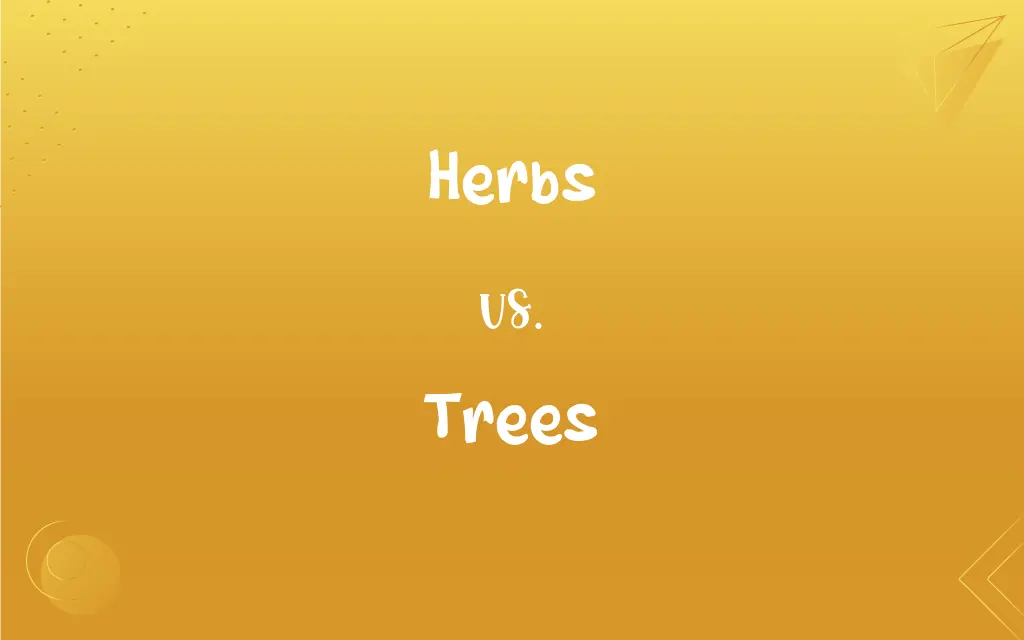Herbs vs. Trees: What's the Difference?
Edited by Aimie Carlson || By Harlon Moss || Updated on October 26, 2023
Herbs are small, non-woody plants used for flavor, scent, or medicinal purposes; trees are large, woody plants with a distinct trunk.

Key Differences
Herbs are typically small, tender plants, often used for culinary, medicinal, or aromatic purposes. Trees, on the other hand, are large, woody plants that grow to significant heights and live for many years.
Herbs usually have a non-woody stem and might die back at the end of the growing season. Trees are characterized by a woody trunk that supports branches and foliage.
Many herbs are grown in gardens or pots for easy access in cooking or medicine. Trees are often found in forests, parks, and landscapes, providing shade and habitat for wildlife.
The lifespan of herbs is generally shorter, ranging from one season to a few years. Trees can live for decades or even centuries, growing continuously.
Herbs are often harvested for their leaves, flowers, or seeds. Trees are valued for their wood, fruit, and ecological benefits.
ADVERTISEMENT
Comparison Chart
Size
Small, non-woody plants
Large, woody plants with distinct trunk
Stem Type
Non-woody, may die back seasonally
Woody trunk, persistent
Common Uses
Culinary, medicinal, aromatic
Shade, habitat, wood, fruit
Lifespan
Shorter, from a season to a few years
Longer, often decades to centuries
Harvested Parts
Leaves, flowers, seeds
Wood, fruit, leaves
ADVERTISEMENT
Herbs and Trees Definitions
Herbs
Plants with aromatic or flavorful properties.
Fresh herbs like basil and mint enhance the dish’s flavor.
Trees
Large, woody plants with a single main stem or trunk.
The oak tree in the backyard has stood there for over a century.
Herbs
Aromatic plants used for seasoning or fragrance.
Lavender is a popular herb known for its soothing scent.
Trees
Woody plants important for ecological balance.
Planting trees helps in combating climate change.
Herbs
Small plants often used in culinary preparations.
Adding herbs to the soup gave it a delightful aroma.
Trees
Perennial plants often providing shade and habitat.
The park is filled with trees that offer shelter to birds.
Herbs
Non-woody plants used in cooking or medicine.
She grew herbs in her kitchen garden for homemade remedies.
Trees
Plants valued for their wood, fruit, and aesthetic appeal.
Fruit trees in the orchard are a source of fresh produce.
Herbs
Plants with medicinal properties used for healing.
Traditional medicine often incorporates various herbs.
Trees
Tall plants with branches and leaves, living for many years.
The forest trail was lined with tall, majestic trees.
Herbs
A plant whose stem does not produce woody, persistent tissue and generally dies back at the end of each growing season.
Trees
A perennial woody plant having a main trunk and usually a distinct crown.
Herbs
Any of various often aromatic plants used especially in medicine or as seasoning.
Herbs
(Slang) Marijuana.
Herbs
Plural of herb
FAQs
What makes a plant an herb?
Aromatic or flavorful properties, non-woody structure.
What are the benefits of trees?
Ecological balance, wood, fruit, shade, habitat.
Do herbs need a lot of sunlight?
Most herbs prefer a good amount of sunlight.
How do trees affect property value?
Healthy trees can significantly increase property value.
Can trees grow in urban areas?
Yes, many species are suitable for urban planting.
What's the difference between a shrub and a tree?
Shrubs are smaller and often have multiple stems; trees have a single trunk.
Are all herbs edible?
Not all; some are purely medicinal or ornamental.
Can trees grow back from stumps?
Some can sprout new growth after being cut.
Are herbs easy to maintain?
Many are low-maintenance and easy to grow.
How long do trees usually live?
Decades to centuries, depending on the species.
Can herbs grow indoors?
Yes, many herbs thrive in pots or indoor gardens.
What are the fastest-growing herbs?
Basil, cilantro, and dill are among the fastest.
Do all herbs have medicinal properties?
Many do, but not all are used medicinally.
Are there perennial herbs?
Yes, some herbs are perennial, living for several years.
Can herbs be used for pest control?
Certain herbs are known to repel pests naturally.
Can herbs grow in cold climates?
Some are hardy, but many prefer warmer conditions.
Do trees need a lot of water?
It depends on the species, but most require regular watering.
What’s the largest type of tree?
Sequoias are among the largest trees in the world.
How do trees communicate with each other?
Through root systems and chemical signals.
How do trees contribute to the environment?
They provide oxygen, absorb carbon dioxide, and support biodiversity.
About Author
Written by
Harlon MossHarlon is a seasoned quality moderator and accomplished content writer for Difference Wiki. An alumnus of the prestigious University of California, he earned his degree in Computer Science. Leveraging his academic background, Harlon brings a meticulous and informed perspective to his work, ensuring content accuracy and excellence.
Edited by
Aimie CarlsonAimie Carlson, holding a master's degree in English literature, is a fervent English language enthusiast. She lends her writing talents to Difference Wiki, a prominent website that specializes in comparisons, offering readers insightful analyses that both captivate and inform.































































